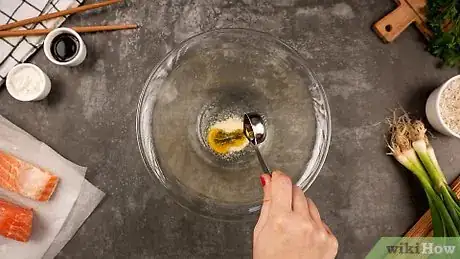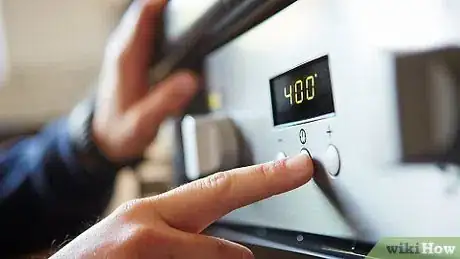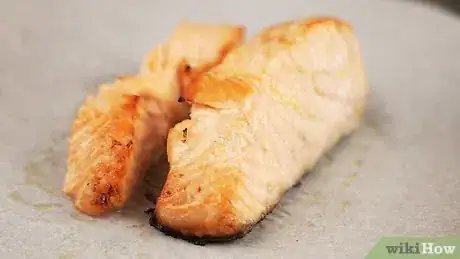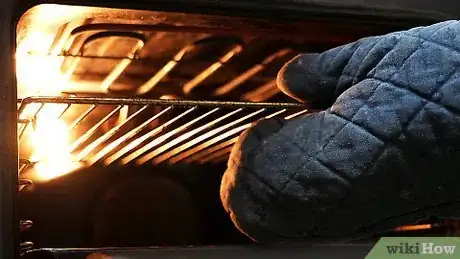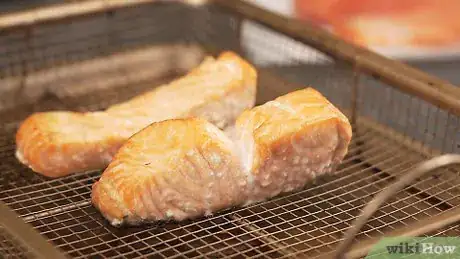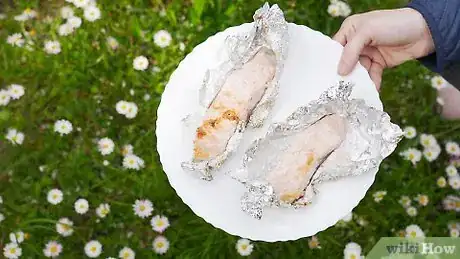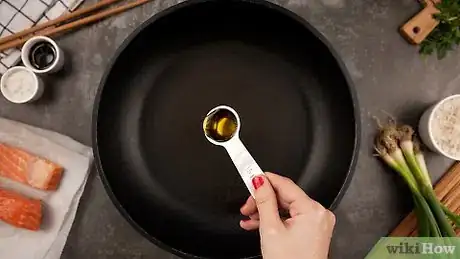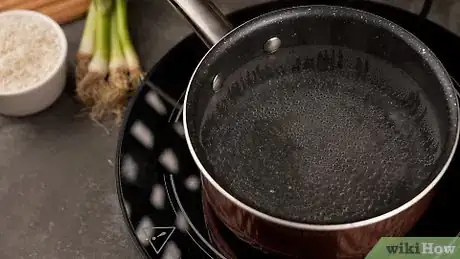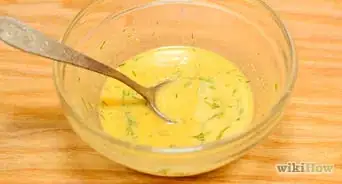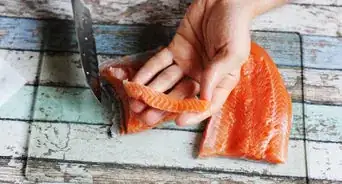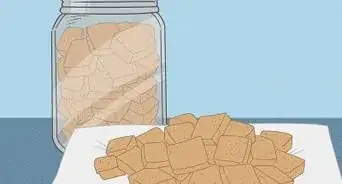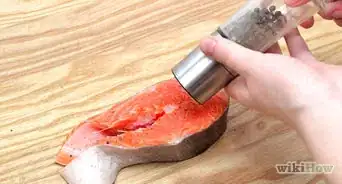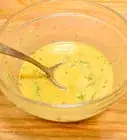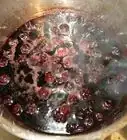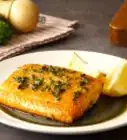This article was co-authored by Ollie George Cigliano and by wikiHow staff writer, Janice Tieperman. Ollie George Cigliano is a Private Chef, Food Educator, and Owner of Ollie George Cooks, based in Long Beach, California. With over 20 years of experience, she specializes in utilizing fresh, fun ingredients and mixing traditional and innovative cooking techniques. Ollie George holds a BA in Comparative Literature from The University of California, Berkeley, and a Nutrition and Healthy Living Certificate from eCornell University.
wikiHow marks an article as reader-approved once it receives enough positive feedback. This article received 21 testimonials and 100% of readers who voted found it helpful, earning it our reader-approved status.
This article has been viewed 2,689,605 times.
Salmon fillets are versatile and delicious, but they cook quickly and require a bit of technique to get right. They are generally prepared by baking, broiling, grilling, pan-searing, or poaching them. Adding a marinade is a common way to infuse the fish with extra flavor. Whether you're a novice in the kitchen or an experienced cook, there's no reason to fear salmon. Skip to Step 1 to marinate your salmon, and then move on to the appropriate following method depending on how you want to cook your salmon.
Makes 4 servings
Ingredients
- 4 salmon fillets, 6-oz (170 g) each
- 1/2 tsp (2.5 ml) garlic salt
- 3 Tbsp (45 ml) lemon juice
- 2 Tbsp (30 ml) olive oil
- 1 to 2 cups (250 to 500 ml) water (for poaching only)
Steps
Marinating the Salmon Fillets
-
1Combine the garlic salt, lemon juice, and olive oil. Whisk the three ingredients together in a small bowl and transfer to a 1-gallon (4-liter) resealable plastic bag.
- You can also use a glass dish covered with aluminum foil instead of the plastic bag.
-
2Coat the salmon. Place the salmon in the marinade and seal the bag. Turn the bag several times to coat all sides of the salmon.
- If using a glass dish, turn the fillets in the marinade several times to coat all sides, then cover the dish with a lid or aluminum foil.
Advertisement -
3Refrigerate for 30 minutes. Place the bag with the marinade and salmon fillets in the refrigerator for 30 minutes.
- Salmon, like all fish, is not as dense as red meats and poultry. As a result, it does not need to be marinaded for long in order to absorb flavor.
- You can also marinate the salmon in the refrigerator for a few hours before you start cooking it.
- Remove the salmon from the refrigerator at least 10 minutes prior to cooking. Doing so raises the temperature, allowing it to cook more evenly throughout.
Baking
-
1Preheat the oven to 400℉ (200℃). Prepare a baking sheet with shallow sides by covering it with nonstick aluminum foil.
- Coat the pan with nonstick cooking spray if you don't have aluminum foil on hand.
-
2Transfer the salmon to the prepared baking sheet. If the salmon fillets have skin on them, lay them skin-side down on the sheet.
- Position the fillets in a single layer, spaced evenly.
-
3Bake for 15 minutes.[1] Place the baking sheet on the middle rack in the oven and cook the salmon until done.
- When done, you should be able to easily flake the salmon apart with a fork. The middle should also be opaque.
-
4Serve at your desired temperature. Salmon fillets can be served warm out of the oven or after they have cooled to room temperature.
Broiling
-
1Preheat the broiler. Allow the broiler to heat up for 5 to 10 minutes.
- Most broilers only have an "on" setting, but if yours has separate "high" and "low" settings, set the broiler to high.
-
2Transfer the fillets to a broiler pan. Place the fillets on the interior rack inside the pan with the skin-side facing down, if applicable.
- Arrange the fillets in a single layer and space them apart evenly.
- If desired, coat the rack with nonstick cooking spray before putting the salmon on it. This is usually unadvised for fatty meats, but not much will drip off the salmon as it cooks. As such, using cooking spray can drastically reduce the amount of salmon that gets stuck to the broiler pan rack.
-
3Broil for 10 to 12 minutes.[2] Place the broiler pan 5 1/2 inches (14 cm) away from the top heating element and cook the salmon until done.
- The salmon is done when you can effortlessly flake the fillets with a fork. The center should be opaque.
- You can turn the salmon once during cooking to ensure even browning, but it is not necessary. Moreover, flipping salmon fillets can be difficult to do and may cause the salmon to fall apart in the oven prematurely.
-
4Serve. Broiled salmon can be served hot out of the oven or at room temperature.
Grilling
-
1Preheat the grill. You can use both gas and charcoal grills to prepare salmon fillets.
- If using a gas grill, preheat the grill to 450 degrees Fahrenheit (232 degrees Celsius).
- If using a charcoal grill, spread a layer of charcoal onto the bottom of the grill and light. Allow the coals to burn and smolder for 30 minutes.
-
2Wrap the salmon fillets in aluminum foil. Place each fillet in the center of a piece of aluminum foil. Bring the sides up and fold them together, sealing the packet. Press any raised aluminum foil flat.
- If using nonstick aluminum foil, place the salmon fillets on the nonstick side.
-
3Transfer the packets to the grill and cook for 14 to 16 minutes.[3] Flip the packets once, at the 7 or 8 minute mark, using grill tongs or a heat-proof spatula.
- Checking the fillets for doneness may be difficult since the foil will be hot to the touch. You may need to wait until after you pull the fish from the grill. If the fillets do not flake easily with a fork or if the center is not opaque, seal the foil again and return to the grill.
-
4Let sit before serving. Allow the salmon to sit off the grill and in their foil packets at room temperature for 5 minutes, then serve.
- This helps seal in the salmon's flavor and juices.
Pan-Searing
-
1Preheat a skillet or sauté pan over high heat. The pan should get hot, but it should not begin to smoke.
- If desired, you can spray a thin coating of cooking spray on the pan or coat it in 1 Tbsp (15 ml) of olive oil before heating it. This step is not necessary if you marinated the salmon fillets or brushed them with olive oil, though.
-
2Place the fish in the preheated pan. Cook for 3 minutes before flipping each fillet over and cooking for an additional 3 to 4 minutes.
- Use a fish spatula to turn the fish. Do not use tongs, since the salmon will likely break apart prematurely if handled with tongs during the cooking process.
- The salmon is done when you can flake the center apart with a fork and when the entire fillet is no longer translucent.
-
3Allow the salmon fillets to cool slightly before servings. After removing them from the heat, you should let the fillets rest at room temperature for 5 minutes before you serve them.
Poaching
-
1Bring the water to a simmer on the stovetop. Place the water in a saucepan with tall sides. Heat over medium heat until the water starts to gently simmer.
- If desired, you can salt the water as it heats up. You can also add one chopped shallot or green onion and several flavorful sprigs of fresh dill, rosemary, or other herbs to the water. This is an especially common way to flavor poached salmon, and is actually more commonly used than marinating.
-
2Add the salmon fillets to the pan. If they still have skins, place the fillets skin-side down. Cover and cook for 5 to 10 minutes.[4]
- If the salmon flakes apart easily with a fork and is no longer translucent inside, it has finished cooking.
-
3Serve warm. Remove the salmon fillets from the heat and let rest for 3 to 5 minutes before serving.
Community Q&A
-
QuestionDo I need to remove the skin before cooking the salmon?
 Community AnswerNo, you don't. However, most people do because of the taste. Personally, I think the skin of a salmon is delicious. It all comes down to your personal preference.
Community AnswerNo, you don't. However, most people do because of the taste. Personally, I think the skin of a salmon is delicious. It all comes down to your personal preference. -
QuestionCan I cook salmon in a cooking bag in the microwave?
 Community AnswerYou can, but I wouldn't recommend it. There are a number of possibilities that could go wrong. For example, the salmon might not cook all the way through, possibly causing you to get salmonella, which isn't very pleasant. It's best to cook it on the grill or in a pan on the stove, not the microwave.
Community AnswerYou can, but I wouldn't recommend it. There are a number of possibilities that could go wrong. For example, the salmon might not cook all the way through, possibly causing you to get salmonella, which isn't very pleasant. It's best to cook it on the grill or in a pan on the stove, not the microwave. -
QuestionWhat do I coat salmon with after it's cooked?
 Community AnswerYou can coat it with anything, it's up to you, but I would recommend butter sauce, lemon sauce or parsley sauce.
Community AnswerYou can coat it with anything, it's up to you, but I would recommend butter sauce, lemon sauce or parsley sauce.
Things You'll Need
- 1-gallon (4-liter) resealable plastic bag or glass dish
- Nonstick aluminum foil
- Cooking spray
- Baking sheet
- Broiler pan
- Grill
- Fish spatula
- Skillet
- Fork
References
About This Article
The simplest way to cook a salmon fillet is to heat a pan with oil on high heat and fry the fillet for 3 minutes on each side. If you want to bake the fillet, marinate it for 30 minutes in the refrigerator, preheat the oven to 400 degrees, and bake for 15 minutes. Keep reading to learn how to grill fillets in foil, poach, and broil them!
